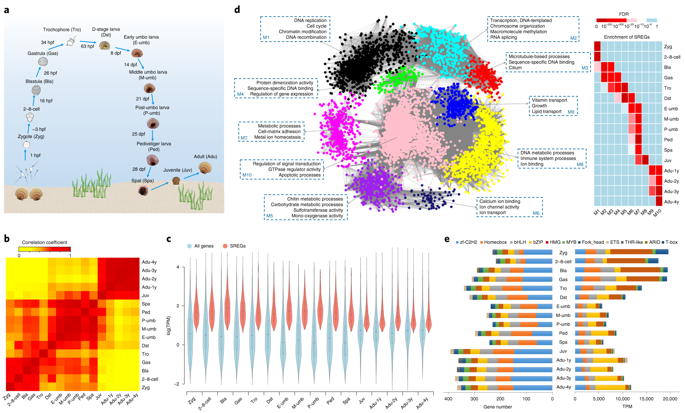当前位置:
X-MOL 学术
›
Nat. Ecol. Evol.
›
论文详情
Our official English website, www.x-mol.net, welcomes your
feedback! (Note: you will need to create a separate account there.)
Evolutionary transcriptomics of metazoan biphasic life cycle supports a single intercalation origin of metazoan larvae.
Nature Ecology & Evolution ( IF 13.9 ) Pub Date : 2020-03-16 , DOI: 10.1038/s41559-020-1138-1 Jing Wang 1, 2 , Lingling Zhang 1, 2 , Shanshan Lian 1, 2 , Zhenkui Qin 1 , Xuan Zhu 1 , Xiaoting Dai 1 , Zekun Huang 3 , Caihuan Ke 3 , Zunchun Zhou 4 , Jiankai Wei 1 , Pingping Liu 1 , Naina Hu 1 , Qifan Zeng 1, 2 , Bo Dong 1, 2 , Ying Dong 4 , Dexu Kong 1 , Zhifeng Zhang 1 , Sinuo Liu 1 , Yu Xia 1 , Yangping Li 1 , Liang Zhao 1 , Qiang Xing 1 , Xiaoting Huang 1 , Xiaoli Hu 1, 5 , Zhenmin Bao 1, 5 , Shi Wang 1, 2, 6
Nature Ecology & Evolution ( IF 13.9 ) Pub Date : 2020-03-16 , DOI: 10.1038/s41559-020-1138-1 Jing Wang 1, 2 , Lingling Zhang 1, 2 , Shanshan Lian 1, 2 , Zhenkui Qin 1 , Xuan Zhu 1 , Xiaoting Dai 1 , Zekun Huang 3 , Caihuan Ke 3 , Zunchun Zhou 4 , Jiankai Wei 1 , Pingping Liu 1 , Naina Hu 1 , Qifan Zeng 1, 2 , Bo Dong 1, 2 , Ying Dong 4 , Dexu Kong 1 , Zhifeng Zhang 1 , Sinuo Liu 1 , Yu Xia 1 , Yangping Li 1 , Liang Zhao 1 , Qiang Xing 1 , Xiaoting Huang 1 , Xiaoli Hu 1, 5 , Zhenmin Bao 1, 5 , Shi Wang 1, 2, 6
Affiliation

|
The transient larva-bearing biphasic life cycle is the hallmark of many metazoan phyla, but how metazoan larvae originated remains a major enigma in animal evolution. There are two hypotheses for larval origin. The 'larva-first' hypothesis suggests that the first metazoans were similar to extant larvae, with later evolution of the adult-added biphasic life cycle; the 'adult-first' hypothesis suggests that the first metazoans were adult forms, with the biphasic life cycle arising later via larval intercalation. Here, we investigate the evolutionary origin of primary larvae by conducting ontogenetic transcriptome profiling for Mollusca-the largest marine phylum characterized by a trochophore larval stage and highly variable adult forms. We reveal that trochophore larvae exhibit rapid transcriptome evolution with extraordinary incorporation of novel genes (potentially contributing to adult shell evolution), and that cell signalling/communication genes (for example, caveolin and innexin) are probably crucial for larval evolution. Transcriptome age analysis of eight metazoan species reveals the wide presence of young larval transcriptomes in both trochozoans and other major metazoan lineages, therefore arguing against the prevailing larva-first hypothesis. Our findings support an adult-first evolutionary scenario with a single metazoan larval intercalation, and suggest that the first appearance of proto-larva probably occurred after the divergence of direct-developing Ctenophora from a metazoan ancestor.
中文翻译:

后生动物双相生命周期的进化转录组学支持后生动物幼虫的单一嵌入起源。
短暂的携带幼虫的双相生命周期是许多后生动物门的标志,但后生动物幼虫如何起源仍然是动物进化中的一个主要谜团。幼虫起源有两种假设。“幼虫优先”假说表明,第一个后生动物与现存的幼虫相似,后来进化成成人添加的双相生命周期;“成体优先”假说表明,最初的后生动物是成体,双相生命周期后来通过幼虫插入而出现。在这里,我们通过对软体动物进行个体遗传转录组分析来研究初级幼虫的进化起源,软体动物是最大的海洋门,其特征是具有承载幼虫阶段和高度可变的成虫形式。我们揭示了承载体幼虫表现出快速转录组进化,特别是新基因的结合(可能有助于成体壳进化),并且细胞信号/通讯基因(例如,caveolin 和 innexin)可能对幼虫进化至关重要。八个后生动物物种的转录组年龄分析揭示了在穴居动物和其他主要后生动物谱系中广泛存在年轻幼虫转录组,因此反对流行的幼虫优先假设。我们的研究结果支持具有单个后生动物幼虫插入的成虫先进化情景,并表明原始幼虫的首次出现可能发生在直接发育的栉水母与后生动物祖先分化之后。并且细胞信号/通讯基因(例如,caveolin 和 innexin)可能对幼虫进化至关重要。八个后生动物物种的转录组年龄分析揭示了在穴居动物和其他主要后生动物谱系中广泛存在年轻幼虫转录组,因此反对流行的幼虫优先假设。我们的研究结果支持具有单个后生动物幼虫插入的成虫先进化情景,并表明原始幼虫的首次出现可能发生在直接发育的栉水母与后生动物祖先分化之后。并且细胞信号/通讯基因(例如,caveolin 和 innexin)可能对幼虫进化至关重要。八个后生动物物种的转录组年龄分析揭示了在穴居动物和其他主要后生动物谱系中广泛存在年轻幼虫转录组,因此反对流行的幼虫优先假设。我们的研究结果支持具有单个后生动物幼虫插入的成虫先进化情景,并表明原始幼虫的首次出现可能发生在直接发育的栉水母与后生动物祖先分化之后。八个后生动物物种的转录组年龄分析揭示了在穴居动物和其他主要后生动物谱系中广泛存在年轻幼虫转录组,因此反对流行的幼虫优先假设。我们的研究结果支持具有单个后生动物幼虫插入的成虫先进化情景,并表明原始幼虫的首次出现可能发生在直接发育的栉水母与后生动物祖先分化之后。八个后生动物物种的转录组年龄分析揭示了在穴居动物和其他主要后生动物谱系中广泛存在年轻幼虫转录组,因此反对流行的幼虫优先假设。我们的研究结果支持具有单个后生动物幼虫插入的成虫先进化情景,并表明原始幼虫的首次出现可能发生在直接发育的栉水母与后生动物祖先分化之后。
更新日期:2020-04-24
中文翻译:

后生动物双相生命周期的进化转录组学支持后生动物幼虫的单一嵌入起源。
短暂的携带幼虫的双相生命周期是许多后生动物门的标志,但后生动物幼虫如何起源仍然是动物进化中的一个主要谜团。幼虫起源有两种假设。“幼虫优先”假说表明,第一个后生动物与现存的幼虫相似,后来进化成成人添加的双相生命周期;“成体优先”假说表明,最初的后生动物是成体,双相生命周期后来通过幼虫插入而出现。在这里,我们通过对软体动物进行个体遗传转录组分析来研究初级幼虫的进化起源,软体动物是最大的海洋门,其特征是具有承载幼虫阶段和高度可变的成虫形式。我们揭示了承载体幼虫表现出快速转录组进化,特别是新基因的结合(可能有助于成体壳进化),并且细胞信号/通讯基因(例如,caveolin 和 innexin)可能对幼虫进化至关重要。八个后生动物物种的转录组年龄分析揭示了在穴居动物和其他主要后生动物谱系中广泛存在年轻幼虫转录组,因此反对流行的幼虫优先假设。我们的研究结果支持具有单个后生动物幼虫插入的成虫先进化情景,并表明原始幼虫的首次出现可能发生在直接发育的栉水母与后生动物祖先分化之后。并且细胞信号/通讯基因(例如,caveolin 和 innexin)可能对幼虫进化至关重要。八个后生动物物种的转录组年龄分析揭示了在穴居动物和其他主要后生动物谱系中广泛存在年轻幼虫转录组,因此反对流行的幼虫优先假设。我们的研究结果支持具有单个后生动物幼虫插入的成虫先进化情景,并表明原始幼虫的首次出现可能发生在直接发育的栉水母与后生动物祖先分化之后。并且细胞信号/通讯基因(例如,caveolin 和 innexin)可能对幼虫进化至关重要。八个后生动物物种的转录组年龄分析揭示了在穴居动物和其他主要后生动物谱系中广泛存在年轻幼虫转录组,因此反对流行的幼虫优先假设。我们的研究结果支持具有单个后生动物幼虫插入的成虫先进化情景,并表明原始幼虫的首次出现可能发生在直接发育的栉水母与后生动物祖先分化之后。八个后生动物物种的转录组年龄分析揭示了在穴居动物和其他主要后生动物谱系中广泛存在年轻幼虫转录组,因此反对流行的幼虫优先假设。我们的研究结果支持具有单个后生动物幼虫插入的成虫先进化情景,并表明原始幼虫的首次出现可能发生在直接发育的栉水母与后生动物祖先分化之后。八个后生动物物种的转录组年龄分析揭示了在穴居动物和其他主要后生动物谱系中广泛存在年轻幼虫转录组,因此反对流行的幼虫优先假设。我们的研究结果支持具有单个后生动物幼虫插入的成虫先进化情景,并表明原始幼虫的首次出现可能发生在直接发育的栉水母与后生动物祖先分化之后。











































 京公网安备 11010802027423号
京公网安备 11010802027423号